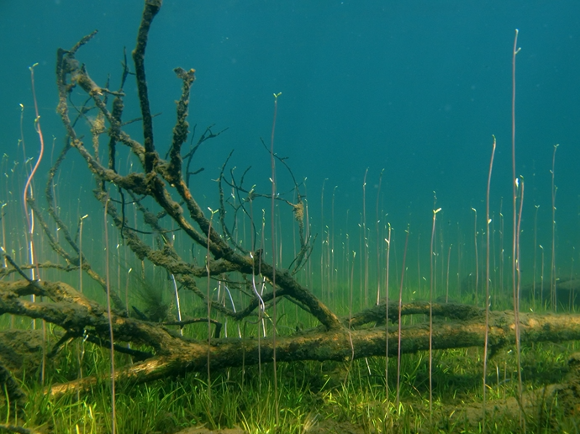 Plant Biology
Plant Biology
Aquatic plants are influenced by the surrounding landscape
Have you ever had an aquarium with plants and failed to make it flourish? In this recent study published in Science, we show that the mineral composition of the soils in the surrounding landscape controls the aquatic vegetation in adjacent lakes, but not in streams, and there are lessons to be also learned for the hobbyist.

Flowering plants living submerged in lakes or streams evolved from terrestrial ancestors. However, successful adaptations to living submerged required several adjustments in anatomy, morphology, and physiology. Nevertheless, all aquatic plants utilize CO2 in their photosynthesis to produce carbohydrates and release O2 as a waste product. However, gases move 10,000-fold slower in water compared to in the air. Thus CO2 in water often becomes depleted since the resupply from the atmosphere above is slow. Many aquatic plants, including several groups of algae, can tap into an alternative source or inorganic carbon and use it in their photosynthesis when CO2 becomes scarce. The alternative source of CO2 is bicarbonate (HCO3-). In most lakes and streams, bicarbonate is present in much higher concentrations than CO2. Hence, plants capable of using bicarbonate have a tremendous competitive advantage. They can continue to photosynthesize when CO2 is depleted and where many competitors give in. The ability to utilize bicarbonate comes at a cost; it requires a unique set of enzymes. Therefore, bicarbonate users are weak competitors in situations where CO2 is not limiting photosynthesis.
Bicarbonate derives from the weathering of calcium carbonate in the soils where groundwater forms. When groundwater seeps into streams and lakes from the terrestrial systems, it carries dissolved CO2 generated by bacteria in the mineralization processes in addition to bicarbonate. However, if there is little calcium carbonate in the soils, the amounts of bicarbonate are low. Therefore, we tested an idea. Lakes and streams situated in landscapes where the soils are rich in calcium carbonate would support few plant species of bicarbonate users. Plants capable of only using CO2 would dominate. In contrast, carbonate-rich soils would generate a high amount of bicarbonate so that bicarbonate users would dominate lakes and streams in such landscapes. We tested the hypotheses by diagnosing 131 species of aquatic plants for their ability to use bicarbonate. Then, we created a global map with information on bicarbonate concentrations in lakes and streams. We overlaid this with more than 1 million global observations of the occurrences of the 131 species with known preferences for bicarbonate versus CO2 use in photosynthesis.
Our analyses confirmed that bicarbonate use is indeed more prevalent among submerged aquatic freshwater plants in lakes with hard water (high amounts of bicarbonate) compared to softwater lakes (low amounts of bicarbonate). In other words, the competitive advantage of using bicarbonate as a source of inorganic carbon also leads to the dominance of plant species with this ability in lakes where the bicarbonate concentration is high. But in softwater lakes with low amounts of bicarbonate, there is no competitive advantage. In fact, quite the opposite because of the cost associated with this trait. Hence, CO2 users dominate in softwater lakes. However, this relationship does not exist in streams and rivers! We have a good explanation for the lack of coupling to bicarbonate concentrations in streams. Streams are inherently high in CO2, so the aquatic plants rarely experience CO2 shortage in streams since these are continuously fed with fresh supplies of CO2 rich groundwater.
The findings of our study are significant because the bicarbonate content of freshwaters changes globally. Human land-use of the catchments (the areas that deliver water to a stream or a lake) results in higher concentrations of bicarbonate favoring bicarbonate users. Bicarbonate users are typically tall and ramifying plants that are also strong competitors. Thus we predict that the much smaller CO2 users will lose the battle. This will change the 3D structure underwater, which is used by fish and crustaceans, particularly in juvenile stages. Therefore we predict a cascading effect at the ecosystem level. These changes are not caused by climate but by eutrophication and liming of agricultural use making intervention possible and tangible. Anglers may see their favorite fish disappear as the underwater landscape is changing.
Original Article:
Iversen L, Winkel A, Baastrup-Spohr L et al. Catchment properties and the photosynthetic trait composition of freshwater plant communities. Science. 2019;366(6467):878-881.Next read: Microplastics are raining down from the sky by Janice Brahney
Edited by:
Massimo Caine , Founder and Director
We thought you might like
Nitrogen pollution from lowlands reaches distant mountain lakes
Sep 21, 2016 in Earth & Space | 3 min read by Beth Hundey , Katrina Moser , Fred LongstaffeConsumed to death: bacteria cause their own extinction by over-polluting the environment
Sep 11, 2018 in Microbiology | 2.5 min read by Christoph Ratzke , Jonas DenkSeal poo unravels the microplastic journey through marine food webs
Oct 8, 2018 in Earth & Space | 4 min read by Sarah NelmsShrimp on cocaine – what’s the big deal?
Jan 23, 2020 in Earth & Space | 4 min read by Thomas MillerMore from Plant Biology
Unravelling the Secrets of Pine Roots: A Tale of Nutrition and Adaptation
Oct 20, 2023 in Plant Biology | 3.5 min read by Rafael Cañas , Francisco OrtigosaStressful memories help plants resist caterpillars
Oct 2, 2023 in Plant Biology | 3.5 min read by Samuel Wilkinson , Adam Hannan Parker , Jurriaan TonDecoding the genome of a jackfruit that grows all year round
Sep 6, 2023 in Plant Biology | 3.5 min read by Tofazzal IslamLife after logging: the tale of recovering tropical forests
Aug 21, 2023 in Plant Biology | 3.5 min read by Maria Mills , Terhi RiuttaEditor's picks
Trending now
Popular topics


